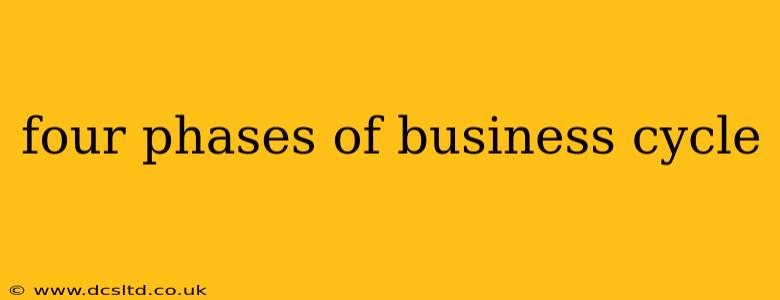The business cycle, also known as the economic cycle, is the natural fluctuation of economic activity over time. It's characterized by periods of expansion and contraction, reflecting the overall health of an economy. Understanding these phases is crucial for businesses, investors, and policymakers alike. This guide delves into the four primary phases: expansion, peak, contraction, and trough. We'll explore each phase in detail, addressing common questions and providing insightful context.
What are the four phases of the business cycle?
The four phases of the business cycle are:
- Expansion: A period of economic growth characterized by increasing employment, consumer spending, and investment.
- Peak: The highest point of the expansion phase, marking the end of economic growth before a contraction begins.
- Contraction: A period of economic decline, often referred to as a recession if it's severe enough. This phase is marked by falling employment, reduced consumer spending, and decreased investment.
- Trough: The lowest point of the contraction phase, representing the end of the economic downturn and the beginning of the next expansionary period.
What is expansion in the business cycle?
The expansion phase is characterized by robust economic growth. Key indicators include:
- Rising employment: Businesses hire more workers to meet increasing demand.
- Increased consumer spending: Consumers feel confident and spend more money on goods and services.
- Higher investment: Businesses invest more in capital goods and expansion projects.
- Growing GDP: The Gross Domestic Product (GDP), a measure of the total value of goods and services produced, increases significantly.
- Rising inflation: Increased demand often leads to higher prices for goods and services. While some inflation is healthy, high inflation can be detrimental.
What is a peak in the business cycle?
The peak marks the end of the expansion phase. At this point, economic activity has reached its highest point before it begins to decline. It's important to note that peaks aren't easily identifiable in real-time; they are often determined retrospectively. Indicators of a peak might include:
- High inflation: Prices have risen considerably.
- Tight labor markets: Unemployment is very low, and businesses struggle to find qualified workers.
- High interest rates: Central banks may raise interest rates to combat inflation, slowing economic growth.
- Overvalued assets: Prices of assets like stocks and real estate may be inflated due to high demand.
What is contraction in the business cycle?
Contraction, often referred to as a recession if it's sustained and severe, is a period of economic decline. Indicators include:
- Falling employment: Businesses lay off workers due to reduced demand.
- Decreased consumer spending: Consumers become more cautious and reduce spending.
- Lower investment: Businesses postpone or cancel expansion projects.
- Falling GDP: The GDP declines for two consecutive quarters or more, signifying a recession.
- Falling inflation (potentially deflation): Reduced demand often leads to lower prices.
What is a trough in the business cycle?
The trough represents the lowest point of the contraction phase. It's the point where economic activity begins to stabilize and eventually rebound. Indicators might include:
- Low inflation or deflation: Prices are at their lowest point.
- High unemployment: Unemployment reaches its peak.
- Low interest rates: Central banks may lower interest rates to stimulate economic activity.
- Undervalued assets: Asset prices are low due to low demand.
How long do business cycles last?
The duration of each phase and the entire business cycle varies considerably. There's no set timeframe. Some cycles are short and mild, while others are long and severe. Historical data shows that business cycles can last anywhere from a few months to several years.
What causes business cycles?
Numerous factors contribute to business cycles, including:
- Technological innovations: Technological advancements can spur economic growth but can also lead to disruptions and job losses in the short term.
- Government policies: Fiscal and monetary policies can influence economic growth or contraction.
- Consumer confidence: Changes in consumer confidence can significantly impact spending patterns.
- Global events: International events like wars, pandemics, and natural disasters can disrupt economic activity.
- Investment cycles: Fluctuations in business investment can drive economic growth or decline.
Understanding the four phases of the business cycle is crucial for making informed decisions in various aspects of life, from personal finance to macroeconomic policy. While predicting the exact timing and severity of these phases remains challenging, understanding the underlying dynamics provides valuable insights.
